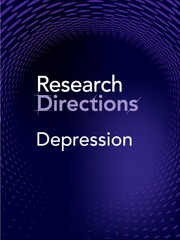One of the most used, but poorly defined, terms in the management of clinical depression is that of treatment-resistant depression (TRD) (McIntyre et al., Reference McIntyre, Alsuwaidan, Baune, Berk, Demyttenaere and Goldberg2023). It implies that persons with major depression have received a range of appropriate psychological, medical or physical treatments (at appropriate doses and for appropriate durations) but have not experienced a significant clinical response. Intrinsically, it does not require consideration as to whether those treatments provided were relevant to their age or developmental stage, clinical phenotype, interpersonal or social context, or personal illness trajectory. These broader clinical considerations often influence initial and subsequent treatment choices.
By contrast, operationalisation of the term ‘TRD’ for use in clinical trials of novel interventions, or in its use by regulatory authorities to authorise access to more restricted (novel or more expensive) treatments, it is often reduced to a very simplistic biomedical concept, that is, failure to respond to at least two common antidepressant medications despite adequate dose, duration and adherence to therapy. That very narrow approach falsely assumes that all persons with major depression are equally likely to respond to each initial and subsequent biomedical intervention (Cuijpers, Reference Cuijpers2023).
More complex criteria, such as the Mass General Hospital Staging Model (McIntyre et al., Reference McIntyre, Alsuwaidan, Baune, Berk, Demyttenaere and Goldberg2023), have been proposed and tested in large health services data sets. These types of approaches incorporate key features such as depression characteristics, treatment history, number of treatment trials and exposure to adjunctive, novel or more intensive (e.g. Electroconvulsive therapy (ECT)) treatment options. However, the development of new medication-based or physical therapies and their proposed optimal use earlier in the treatment pathway challenges many underlying assumptions. Additionally, the lack of emphasis on the utilisation of appropriate psychological, behavioural and social interventions, again earlier or concurrently with biomedical treatments, is intrinsic to many such approaches.
Three of the most challenging (and intrinsically linked) concepts that are not well represented in the current literature on TRD are that of younger age and earlier developmental stage, clinical staging and the appropriate sequencing or combination of treatments. First, medical and psychological treatments for depression are now being delivered increasingly to younger (typically adolescent) cohorts as part of the broader drive to promote early intervention for major mood or psychotic disorders (Hickie et al., Reference Hickie, Scott, Cross, Iorfino, Davenport and Guastella2019; McGorry et al., Reference McGorry, Mei, Chanen, Hodges, Alvarez-Jimenez and Killackey2022). Importantly, younger persons have a lower response rate to both common psychological and medical therapies than those in mid-life (Cuijpers et al., Reference Cuijpers, Karyotaki, Eckshtain, Ng, Corteselli and Noma2020). A range of key brain (i.e. cortical and white matter) and linked neurobiological (e.g. circadian, immune and metabolic) and cognitive (e.g. affective regulation) systems have not yet completed their developmental phases at the time that many young people are being exposed to these conventional treatments.
Next, these earlier ages of exposure to interventions are linked to clinical staging, an emerging clinical paradigm which places a strong emphasis on early identification and active management of syndromes in those presenting for health care (Hickie et al., Reference Hickie, Scott, Cross, Iorfino, Davenport and Guastella2019). It encourages actions to be taken that may well be characterised as indicated prevention (providing active interventions to those with sub-threshold affective syndromes) or early intervention (active treatments for those with clear affective syndromes). This approach has twin goals – reducing current symptoms, while also preventing progression to more persistent, severe or recurrent syndromes.
Clinical staging also has a clear emphasis on providing active interventions with the least risk of adverse outcomes – so it prioritises the early use of psychological, behavioural or social approaches over medical or physical therapies for the initial stages of illness. Within this concept, those who have already progressed to more persistent, recurrent or comorbid clinical phenotypes are often managed with more complex, multimodal or prolonged treatment regimens – for both treatment of the current illness episode and prevention of recurrence.
Third, a sequential or combination approach to treatments (as articulated within some clinical guidelines) emphasises preference for early exposure to psychological therapies in those with major depression, unless they have features suggesting preferential response to medications (e.g. psychotic features, severity, or observed psychomotor changes). However, such non-medical interventions are less likely to be provided in settings where these interventions are not readily available or require considerable personal payment. Additionally, an emphasis in optimal clinical practice is also placed on ongoing or combined use of appropriate psychological, behavioural and social strategies, alongside medical interventions, throughout the illness journey.
The response rates for first exposure to each of the well-recognised medical, psychological or physical treatments provided to persons who meet criteria for major depression are typically in the order of 30–40% (Byrne et al., Reference Byrne, Kirk, Medland, McGrath, Colodro-Conde and Parker2020; Cuijpers et al., Reference Cuijpers, Karyotaki, Ciharova, Miguel, Noma and Furukawa2021). For those who are in the control arm of relevant Randomised Control Trials (RCTs) of these specific treatments, the typical response rate was 20–30%. Additionally, the response rate in standard care systems (including those who responded without receiving any specific treatments) is in the order of 10–20%. That is, only a small proportion of people respond specifically to the first intervention they are offered.
Importantly, the likelihood of responding specifically to a second treatment in those who have failed to respond to the first treatment, or to then remit spontaneously, is lower than that observed in those entering treatment for the first time (Cuijpers, Reference Cuijpers2023). Therefore, people who do not respond initially will need to be treated with other options, in some cases many more, while hardly any research is available on the optimal subsequent sequence of alternative treatments.
A consequence of our lack of knowledge about optimal initial and subsequent treatment choices for those presenting with major depression is that many individuals are often very quickly, and probably wrongly, labelled as ‘treatment-resistant’ relatively early in their illness journey. This is particularly likely to be the case when each ‘new’ treatment offered does not substantially differ in its mode of action from the previous failed treatment. It is not uncommon to encounter people who have received two or more selective serotonin reuptake inhibitors (SSRIs), without trials of differential medical or physical therapies or exposure to relevant psychological therapies and been labelled as ‘TRD’. An important reality, however, is that our current range of very similar medical treatments are insufficient to meet the needs of a substantive subgroup of those who present for care (in the range of 20–40%) (Byrne et al., Reference Byrne, Kirk, Medland, McGrath, Colodro-Conde and Parker2020) and that this proportion is not reduced by simply increasing the number of medicines provided.
Further, it is clear that various clinical phenotypes – notably psychotic depression, bipolar depression, atypical depression, major depression that is comorbid with alcohol or other substance misuse, major depression that is comorbid with specific anxiety disorders, major depression that is comorbid with specific personality characteristics, perimenopausal depression, postnatal depression, late-onset depression that is comorbid with subcortical brain changes – would not be expected to respond optimally to a generic course of one or two of the most commonly used antidepressant medications alone or a range of common psychological therapies (Cuijpers et al., Reference Cuijpers, Miguel, Ciharova, Quero, Plessen and Ebert2023). For many of these specific clinical scenarios, the optimal sequence of treatment choices has not been established empirically.
The real alternative to current notions of TRD is a focus on a clinical paradigm, and linked clinical research, that integrates highly personalised initial assessment, with ongoing measurement-based care (Reference Iorfino, Cross, Davenport, Carpenter, Scott and ShiranIorfino et al., 2019; Hickie et al., Reference Hickie, Scott, Cross, Iorfino, Davenport and Guastella2019; Hickie, Reference Hickie2020; Shah et al., Reference Shah, Scott, McGorry, Cross, Keshavan and Nelson2020). This approach may permit the true trajectory of illness response to be determined for each individual at the time they enter clinical care and subsequently over their illness course. The logic here prioritises an optimal first choice of single or combination treatments (based on age and developmental stage, clinical stage, key phenotypic features, personal illness trajectory, comorbid factors and personal choice), followed by modifying the sequence of further choices (in the event of suboptimal response) on the basis of emerging characterisation of each individual’s illness type, course and patterns of partial response, or adverse reactions, to various interventions.
This quite different research paradigm requires the recruitment of very different clinical cohorts to clinical trials – for both existing and new therapeutic options and combinations. It places much greater emphasis on resolving those individual factors which are much more predictive of delivering specific responses to the range of medical and psychological therapies available. It also requires a long-term perspective on achieving optimal outcomes through the delivery of the optimal sequence of interventions, rather than simply focusing on the evaluation of the short-term response to each new therapy.
How to contribute to this Question
If you believe you can contribute to answering this Question with your research outputs, find out how to submit in the Instructions for authors (https://www.cambridge.org/core/journals/research-directions-depression/information/author-instructions/preparing-your-materials). This journal publishes Results, Analyses, Impact papers and additional content such as preprints and ‘grey literature’. Questions will be closed when the editors agree that enough has been published to answer the Question so before submitting, check if this is still an active Question. If it is closed, another relevant Question may be currently open, so do review all the open Questions in your field.
For any further queries check the information pages (https://www.cambridge.org/core/journals/research-directions-depression/information) or contact this email (depression@cambridge.org).
Competing interests
Ian Hickie is the Co-Director, Health and Policy at the Brain and Mind Centre (BMC) University of Sydney. The BMC operates an early-intervention youth services at Camperdown under contract to headspace. He is the Chief Scientific Advisor to, and a 3.2% equity shareholder in, InnoWell Pty Ltd which aims to transform mental health services through the use of innovative technologies.







